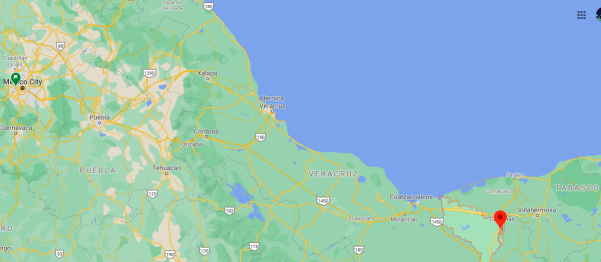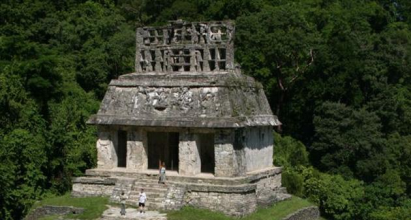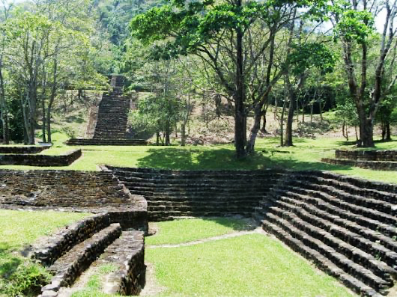Huimanguillo, Tabasco 作者: 来源: 发布时间:2021-11-17
1.Population and Area
Pop: 26,402 (city)
Area: 3.757,59 km2 (munip.)
Elev: 10 masl

Huimanguillo location in Mexico within the state of Tabasco
https://goo.gl/maps/6hSB51TECrB7uegt6
2. Natural geography
Orography
Due to its size, this municipality has three different forms of relief; in the western part it has characteristic soils of coastal zones, which cover 2% of its surface; the southern part presents a mountainous relief, which covers 11% of the territory. The remaining 87% of the municipal area is occupied by the Tabasco plain, which is the dominant landform in the state.
In the municipality of Huimanguillo is the Mono Pelado hill, which, at 1000 meters above sea level, constitutes the highest point in the state; It also serves as the boundary between the states of Chiapas and Tabasco. Other hills, of lower elevation, are those of La Pava, La Ventana, La Copa and Las Flores.
Flora and fauna
In this area there are areas with diverse vegetation, where we can find high evergreen rainforest with trees over 30 m high and some medium evergreen rainforest 15 to 30 m high, such as cedar, mahogany and tatuán.
Much of the forest resources have been cut down, which has caused the formation of different secondary forest. Another important type of vegetation is the popal, low flooded soils, where corn, beans and squash are grown at different times of the year.
Lastly, a fairly large extension of savannas (140,000 hectares) used mainly for cattle raising is detected, whose characteristics are natural grass 1.5 m high.
The fauna of the municipality is scarce, largely due to the lack of vegetation, however, some species can be mentioned such as the saraguato, rabbit, tepezcuintle, turtle, and a great variety of birds.
Weather
Due to its orography, Huimanguillo presents two types of climate; The first is the warm humid one with abundant rains in summer (Am), which is the dominant climate in Tabasco, with an average annual temperature of 26.2 ° C, with a maximum average monthly of 30.6 ° C in the month of May and a maximum 45 ° C absolute; the absolute minimum reaches 14 ° C. This type of climate occurs in the low and flat areas of the municipality.
In the areas that present a mountainous relief, the warm humid climate with rains all year round (Af) is appreciated, which is the climate that the high jungles of Chiapas, Veracruz and the Tabasco mountains present; whose average temperature varies between 25.4 ° C and 26.9 ° C. There is little variation in rainfall throughout the year, although these decrease in winter, occurring in this season, only 14.4% of the annual total.
Average annual rainfall is 2,290.3 mm, with a monthly maximum average of 322 mm in September and a minimum of 0 mm in April.
The biggest gales occur in the months of November and December with maximums of 30km / h, the minimum being located in the month of May, being of the order of 18km / h.
https://weatherspark.com/y/10045/Average-Weather-in-Huimanguillo-Mexico-Year-Round#Sections-Temperature
Getting there and around
Get there
By air – The quickest way to get from Mexico City to Huimanguillo is to fly. You can fly to the Villahermosa airport and take a bus or drive from there to Huimanguillo. The quickest flight from Mexico City Airport to Villahermosa Airport is the direct flight which takes 1h 20m.
By car – The distance between Mexico City and Huimanguillo is 630 km. The road distance is 721.1 km., and it takes 9h 30m, approximately, via 150D and 145D highway.
By bus – The cheapest way to get from Mexico City to Huimanguillo is to bus via Minatitlán which costs $650 - $1300 and takes 14h 11m. There are services departing from México TAPO and arriving at Huimanguillo via Puebla Terminal CAPU and Cárdenas. The journey, including transfers, takes approximately 12h 58m.
https://www.rome2rio.com/s/Mexico-City/Huimanguillo
Car Rental – To explore Mexico’s provincial towns and cities—including its beach locations and the scenery and attractions near them— consider renting a car for your visit. Having your own car will give you more flexibility than using public transport options and, in some cases, offer you access to places which are otherwise difficult to visit without the use of a car.
COVID19 – International entry into Mexico from United States
Allowed for: All visitors arriving by air. Mexico land borders are closed to non-essential travel
Restricted for: There are no current restrictions.
Get around
Local Buses – Local buses and mini-buses (combis or micros) are available locally for a fraction of the cost of a taxi around town. You need to speak Spanish to be able to ask for directions or ask the driver to tell you where to get off.
Taxis – Taxis in most of Mexico’s towns and cities are not metered, so agree your price before you get in. Taxi travel is very affordable in Mexico, in comparison to the USA, Canada and Europe, and so provides a viable means of public transportation in Mexico. Your hotel can arrange taxis for you; some post their rates on a board in the lobby; taxi hotel rates are usually higher than cabs you hail off the street. If you speak Spanish, you will have a distinct advantage and be able to negotiate a price with the driver.
Uber is expanding rapidly across Mexico and now offers services in cities across the country, including: Mexico City, Toluca, Cuernavaca, Puebla, Querétaro, León, Aguascalientes, San Luis Potosí, Guadalajara, Monterrey, Hermosillo, Tijuana, Mexicali, and Mérida. Uber has been adding Mexican cities to its network every year, check for availability when you arrive at your destination in Mexico.
Cabify and Didi are also developing and currently operate in cities including Mexico City, Toluca, Monterrey, Puebla, Querétaro and Tijuana. Check for availability in the city you are visiting.
These services offer people with smartphones a way to book a cab through a mobile app for a pre-agreed price. Fares are comparable with Sitio type cabs, and sometimes trade at a premium to this when local demand increases.
https://www.mexperience.com/transport/taxi-travel-in-mexico/#51
3. ECONOMY
GDP: 10,214 M MXN (2010)
https://imco.org.mx/ciudades2010/ciudades/83_Huimanguillo.html
4. Industry characteristics
Farming
The agricultural activity in the municipality is destined to the production of citrus fruits and basic grains. Huimanguillo, is the main citrus producer in the state. In 1997 the planted area was 59,970 ha. Of that area, corn cultivation represented 32.44%, fruit trees such as orange represented 29.60%, lemon 3,276 represented 5.46%; pineapple occupied 9.67% (being the main producer in the state); cocoa occupied 13.32%; sugar cane represented 8.0%; and rice occupied 2.25% of the total municipal agricultural area.
Cattle raising
It is one of the main livestock areas in the state, ranking second in importance for its production of beef and dairy cattle. As a poultry producer, it ranks first in the state, and is a major producer of pigs, sheep, and horses.
Forestry
Huimanguillo is the municipality with the largest extension of commercial forest plantations in the country, since the mid-nineties a series of projects has been established in the entity, exceeding 15,000 ha planted with timber species such as eucalyptus, melina, teak and rubber.
Industry
This activity has increased in recent years, with the oil industry standing out, particularly well drilling. Petroleos Mexicanos has hundreds of facilities in the municipality, among which the following stand out: The "La Venta" Gas Processing Complex, the "Tecominoacán", "Paredón" and "Jujo" separation and compressor batteries, as well as hundreds of producing wells among the They include: Five Presidents, Magallanes, Ogarrio, Blasillo, Tembladeras, Otates, Tecominoacán, Mecatepec, Giraldas, Jujo, Paredón and San Manuel.
Agribusiness is developing. In the town of Martínez Gaytán there is a cassava dehydration plant, the first of its kind in terms of technology in Mexico and worldwide.
In the town of Pino Suárez there is also a cassava processing plant and a citrus plant called Citrus, although it is no longer working due to the fact that under the production of raw material (orange) and in the municipal seat there is a factory that processes pineapple jam from industries. Bimbo.
Key project: Construction of the Chontalpa train station
It will be part of the complementary project to the construction of the Refinery in Paraíso; The Federal Government will invest in the construction of the Dos Bocas-Chontalpa Station railway line.
It is a project with federal investment, where the Refinery will have a railway from Dos Bocas port to Chontalpa Station, with an approximate stretch of 100 kilometers, to be able to transport its products to the port of Coatzacoalcos, Veracruz.
http://www.diariodetabasco.mx/tabasco/2019/05/22/aplauden-huimanguillo-quede-incluido-en-proyecto-la-refineria
5. Attractions
La Venta

The archaeological zone of La Venta belongs to the Olmec culture, whose importance resides mainly in its antiquity, since its main pyramid is considered the oldest in Mesoamerica, in the pattern and orientation so regular of its extensive architectural design and in its function with a civic - ceremonial and residential center.
The main sales boom occurred between 1000 and 600 BC. During this period, the city apparently covered an area of about 200 hectares, and in its immediate surroundings there was an extensive fluviolagunar network, rich in flora and fauna. Today you can see numerous mounds that, in their time formed architectural complexes or complexes, most of the buildings had the same orientation and were arranged along the north-south axis; They were constituted by platforms made by accumulating huge amounts of different types of earth, clay and sand, and on these were erected constructions of perishable material such as: low-rise walls and palm roofs. In general, the platforms are 3 to 4 meters high, and a maximum of 100 meters long.
In the archaeological zone there is a site museum, which offers a general panorama of what the Olmec culture was, mainly in La Venta. It exhibits the model of the area and a large number of archaeological pieces; also explanatory texts, photographs, paintings and drawings.
Agua Selva

Agua Selva is an ecotourism area where the water element and the jungle are perfectly linked to offer the visitor a splendid natural panorama. It is located in the Sierra de Huimanguillo 142 km from the state capital (Villahermosa). It comprises approximately one thousand hectares of extension that due to the abundant wildlife that exists there has been considered an ecological reserve area. The area has cabins, restaurant, tours and waterfalls. Ecotourism activities such as rappelling, and hiking can be carried out among others.
Agua Selva offers impressive landscapes made up of evergreen jungle vegetation and the imposing beauty of streams, naturally formed pools and a good number of crystal-clear waterfalls. Also included are two capricious geological formations known as La Pava and La Copa, as well as innumerable depressions and hollows of the mentioned mountain range.
Of the waterfalls, the one called Las Flores, is the highest in the area, measuring more than a hundred meters and in the middle of it, a tree is located hugging a huge stone in conjunction with the rugged cliffs and the surrounding vegetation. they constitute an important natural attraction.
Among other waterfalls are the so-called: Velo de Novia, Las Golondrinas and Los Tucanes. In the last two, during spring and summer, a multitude of beautiful birds can be admired.
Malpasito

The archaeological zone of Malpasito with characteristics of the Zoque culture. Its occupation occurred during the late classical period between 700 to 900 AD. C. The distribution of its buildings follows a south-north axis, taking advantage of the terrain relief, the ball court and various structures that delimit a sunken courtyard and the main square of the complex stand out.
Another attraction are the petroglyphs that are located in the vicinity of the archaeological zone and in nearby ejidos such as Malpasito, Villa Guadalupe and Francisco J. Mújica. In these rocks, animal characters and geometric designs were represented, some of them with symbolic character related to fertility rites and hunting in these engravings, models of settlements and construction profiles are also represented.

Búfalo, cascadas, rappel y ruinas en Agua Selva || Tabasco #4
https://youtu.be/c_BOnVGht24
6. History
In the territory of what is now the municipality of Huimanguillo, around 1000 BC. C. the Olmec culture flourished (inhabitants of the rubber region), also called the mother culture of Mesoamerica; whose political and religious center was in what is now known as La Venta.
In the Archaeological Zone of La Venta, important vestiges have been found, such as the colossal heads, popularly called Olmec heads and other gigantic monoliths that are currently exhibited in the La Venta museum park in the state capital; as well as the oldest pyramid in Mesoamerica, and one of the oldest in the New World. What makes the site one of the main centers of the Olmec civilization. These vestiges reveal an evolved and enigmatic culture to us.
The splendor of this culture began its decline from 600 to 400 BC. approximately C. and occupied much of the Mesoamerican territory, part of what we know today as Veracruz and Tabasco mainly. The known ceremonial centers are Tres Zapotes, San Lorenzo, the oldest, and La Venta, the main one.
From the years 400 to 900 AD. of C. in this zone the Chontales distinguished themselves as a town of merchants with marked Nahua influences and of Mayan origin. However, they were a people that could never fully develop due to heavy incursions from other dominant peoples such as the Itzaes and the Toltecas. Towards the arrival of the Spanish, this area was dominated by an important lord who regulated trade and maritime routes with other peoples, especially with the Aztec empire, of which he was a tributary. The river that the Spanish baptized as Grijalva, bore his name and this was Taabscoob, from which the word Tabasco is believed to come.
In what is now the Santa Ana bar and the Tonalá river, another small Nahuatl group prevailed among the diverse ones that still conserved characteristics of their roots and of their political organization and language. This group known as the Ahualulcos changed their place of residence around the year 1680 harassed by the pirate incursions of Lorencillo (Laurens de Graaf) at the time of the dispersal they were divided into four groups which were previously distinguished by cozoliacaques, the tecominuacanes, mecatepeques and huimangos.
According to the priest Manuel Gil y Sáenz in relation to the founding of the city of Huimanguillo, the Cozoliacaques moved to Acayucan. The Tecominoacanes were divided into two, one settled in Cunduacán, founding the town of Boquiapa and the other settled in Huimanguillo with the same name as Tecominuacán. The Mecatepeques settled between Tecominuacán and Ocuapan. And the huimangos in turn were divided into three parts. One founded the town of Huimango in Cunduacán, the other, mixing with the white race, settled in Ocuapan and the third founded what is now Huimanguillo. Despite this, it is believed that the population of Huimanguillo already existed one hundred years before these events.
After the conquest, the Ahualulco peoples, of Nahuatl descent, were displacing the Zoque cultures that prevailed there and that were of very ancient origin, from the Mixe Zoque trunk, almost certainly descendants of the Olmecs.
Later the Indians of these provinces were entrusted to Teodora Manuel. We can read this in the following fragment from Manuel Mestre Ghigliazza "The towns that are included in the province of Tabasco, Yucatan governorate and the tributary Indians that there in each town and the people to whom they are entrusted are the following: Queimanguillo has five tributaries who pay five xiquipiles of cocoa and five chickens for half two hanegas and a half of corn. They are entrusted to Teodora Manuel as the first charge. "
The diversion of the channel of the Mezcalapa River in 1770, carried out by the inhabitants of Chontalpa to avoid the pirate incursions, caused the general intendancy of Guatemala to try to extend its dominions to Huimanguillo, but this was prevented by the Mayor of Tabasco and by the intervention of the viceregal government of New Spain. Indeed, in 2 old maps that are now exhibited in the municipal archive of Cárdenas, Tabasco, dated 1776 and 1777, the territory of Huimanguillo appears with the name of Guatemala.
Huimanguillo is annexed to Tabasco
For the nineteenth century in 1811 and between the political differences and due to the neglect in which the province of Tabasco had remained throughout the Spanish domination, Dr. José Eduardo de Cárdenas representing Tabasco before the Cortes of Cádiz in Spain and deputy of the province included in the Memorial in favor of the peoples of Tabasco the request that Huimanguillo be annexed to the state of Tabasco. The aforementioned doctor expressed:
The dividing line can be called truly mathematical: there are no stable markers and the site of the real ones has been in question for a long time; but this business of not very little consideration, almost since it arose, sleeps in a very deep sleep. Once the inmates were transferred without any work from Tabasco to Ahualulcos, and from Ahualulcos to Tabasco, they no longer reach the arms of the respective territorial judges, who are ordinary in competitions; and thus the most serious and urgent provinces are scandalously and ridiculously avoided.
And here he asked for the annexation of the Ahualulcos party to Tabasco:
"Add to Tabasco everything that mediates between the current limits and the mighty river of Tonalá; a space that will only consist of 17 leagues in which there are at most five towns and of them only a considerable one, Huimanguillo."
From the initial decades to the seventeenth century, the Tabasco authorities had made the first requests to dismember the Ahualulcos party of the Coatzacoalcos province, and annex it to the Tabasco province, "because they lack the administration of the holy sacraments and that of justice, because of the distance of 40 leagues from the unpopulated area and 16 more than half the head of the aforementioned party, which make up 56, and there are only 12 to the aforementioned Tabasco, and to be a haven for criminals and outlaws of this.
Likewise, earlier in 1803, the governor of Tabasco raised a situation with the Viceroy concerning his province and that included the problem "the damage caused by the proximity of the towns of Ocuapan and Huimanguillo, then corresponding to the Veracruz administration." it referred to the prompt need to integrate both to Tabasco as the only solution to the problem. Finally and thanks to what was formulated by José Eduardo de Cárdenas and Romero in the Cortes of Cádiz, the Huimanguillo party is integrated, which includes the towns of Zanapa, Ocuapan, Mecatepec and Huimanguillo with all their farms and ranches.
The libertarian struggle
In February 1816, the second armed outbreak occurred by the national independence struggle in Tabasco, when Atanacio de la Cruz took up arms and took the town of Huimanguillo, he also intended to take Cunduacán, Acayucan, Guazacoalcos and Tonalá, however, it was defeated and imprisoned by Governor Francisco de Heredia y Vergara.
On August 25, 1821, Captain Juan Nepomuceno Fernández Mantecón arrived in Huimanguillo where independence was sworn that same day, and where he was joined by many supporters including Fernando Nicolás Maldonado and José María Jiménez Garrido.
The dispute over territory
In 1840 the canton of Huimanguillo was separated from Tabasco to be annexed to the district of Acayucan, Veracruz, however, the protest of the Tabasco authorities and the intervention of the then governor of the state José Víctor Jiménez, who on June 4, 1856 rose to the platform of the Constituent Congress to request that Huimanguillo be reintegrated to Tabasco, as the following text of his speech can be seen:
The District of Huimanguillo belonged to Tabasco still in 1812 (...) due to the territorial redistribution of Mexico, the District in question was taken from Tabasco to be annexed to Veracruz, however, its capital is far from this The population is almost 6 days away, while the Capital of Tabasco is barely eighteen leagues away, in addition to having a great exchange of commerce, traditions and families with the Province of Tabasco, so its inhabitants wish to be reintegrated into the state...
Derived from the above, the Constituent Congress, resolved and established in the Constitution of 1857 that Huimanguillo would be reintegrated into the state of Tabasco as the head of the party, having Tecominuacán, Mecatepec, and Ocuapan as towns, with all their banks, farms and rancherías. "When the Constitution of 1857 in its fourth article, granted Tabasco legal possession of the then canton of Huimanguillo, a point of conflict between this state and that of Veracruz was ended, in legal terms; a conflict that had its gestation and a good part of its development throughout the colony".
However, on March 3, 1865, with the Second Mexican Empire, the canton of Huimanguillo was again separated from Tabasco and annexed to the department of Tehuantepec. But with the fall of the Second Mexican Empire, and the restoration of the Constitution of 1857, Tabasco recovered this territory again.
Huimanguillo in the Mexican Revolution
In 1902 the anti-reelectionist club Melchor Ocampo was integrated, it was the first group organized in Huimanguillo and that heralded the beginning of the revolution in Tabasco. The board of directors was made up of President Fernando Aguirre Colorado, vice president Rubén del Valle, first member Saúl del Valle and Pedro C. Colorado was first secretary, all of them also belonging to the local Masonic group.
During the beginning of the revolutionary struggle in Tabasco, many were the Huimanguillenses who took up arms and joined General Ignacio Gutiérrez in the fight against Governor Abraham Bandala in 1910, among them: Pedro C. Colorado, José Acuña Pardo, César Brito and N. Balcazar Santana.
In 1911, the first "revolutionary baptism" in the Republic was held in Huimanguillo, at the home of Dr. Adolfo S. Aguirre. The officiant who replaced the priest, pouring water from the Mezcalapa River on the head of the child José Manuel Aguirre del Valle, said: "I baptize you José Manuel in the name of freedom."
Later, after the assassination of Francisco I. Madero and Pino Suárez, the Maderistas gathered in Huimanguillo. The brothers Ernesto and Fernando Aguirre Colorado, Isidro Cortés, Áureo L. Calles, Aureliano and Pedro C. Colorado launched the cry of rebellion on April 5, 1913 and forming a group of 100 men they took the town of Cárdenas and the next day 6 April, they took the town of Huimanguillo.
They were joined by brothers Alejandro and Carlos Greene, and on April 8 they launched their proclamation, ignoring Victoriano Huerta, against the restoration of the Porfiriato, in defense of non-reelection and for individual guarantees. Thus, on May 28, 1913, they formed the "Constitutionalist Army of the West of Chontalpa", naming as their first chief the Huimanguillense Pedro C. Colorado, accompanied by Aurelio Sosa Torres and Carlos Greene. Managing to take the state capital on September 2, 1914.
Discovery of Sale
In 1925, the explorers Frans Blom and Oliver La Farge, arrived across the Blasillo river to what was the islet of the largest Olmec center: La Venta, announcing the news in 1926 in their book "" Tribes and Temples ". Later, in 1938, the archaeologist Matthew Stirling made sensational discoveries in La Venta, mainly the colossal heads, and drew up a map of the area.In 1939 and 1965 he published several works on the Olmec culture.
In 1957 the Southeast Railroad was inaugurated, communicating the municipality of Huimanguillo with the rest of the country, having 6 stations in its territory.
7.Contact Information

City Mayor: José Del Carmen Torruco Jiménez
Phone number: +52 (917) 375 0315
E-mail: presidencia@huimanguillo.gob.mx
Website: https://huimanguillo.gob.mx
Govt. Office Address: Av. Miguel Hidalgo S/N Col. Centro, Huimanguillo, Tab. C.P. 86400
